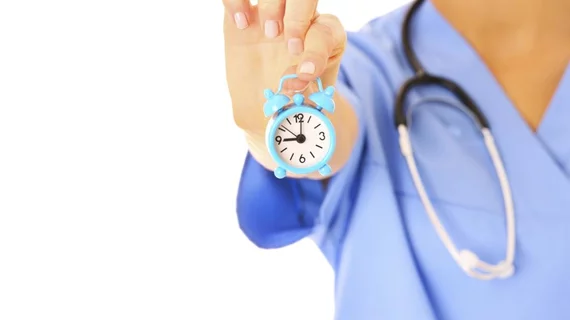Around 3 percent of radiology patients miss pre-scheduled imaging appointments at any given time, researchers out of the University of Washington report in the Journal of the American College of Radiology (JACR)—but mammography and ultrasound see no-show rates more than double that.
First author Joshua I. Rosenbaum, MD, and colleagues said in JACR that medical no-show visits are “missed healthcare opportunities” and ones that negatively affect departmental efficiency. Further than that, they wrote, diagnosis and treatment delays mean worsened patient care and upticks in morbidity and mortality.
“No-show visits also confer a negative impact on other patients, because a different patient could have been imaged during the unutilized time slot,” the authors wrote. “[And] besides the more obvious lack of revenue generation that is associated with an unused appointment, there is also sunk cost from the utilization of human resources for scheduling, determining examination protocol and financial pre-authorization.”
Researchers have collected no-show data in the past, Rosenbaum et al. explained, but radiology is unique in that its reasons for no-shows could revolve more around anxiety, cost of care and misunderstandings about exams than other mainstream specialties.
The authors conducted a retrospective analysis of 2.9 million outpatient visits at their University of Washington facilities between 2000 and 2015. Accounting for variables like imaging modality, patient age, appointment time and day of the week and scheduling lead time, the team analyzed no-shows in radiography, CT, mammography, MRI, ultrasound and nuclear medicine exams.
Throughout the full study period, 94,096 of 2,893,626 patient visits were no-shows, Rosenbaum and colleagues found, accounting for 3.25 percent of imaging appointments. That number fluctuated during the 15 years, reaching 3.36 percent in 2000 and bottoming out at 2.26 percent in 2015.
The effect size for no-shows was strongest for modality and scheduling lead time, the authors said, with scheduling lead times of greater than six months linked to more no-shows than scheduling within a week of the exam. Mammography led the no-show cohort with 6.99 percent of missed appointments, compared to radiography’s 1.25 percent.
Rosenbaum and co-authors said mammography, and the second-highest no-show modality, ultrasound, were likely poorly attended due to their nature as screening tests.
“In general, screening examinations have a low rate of disease, and patients often feel that there is little harm in postponement of the examination,” they wrote. “Ultrasound similarly has a large proportion of planning and may also encourage the deployment of different patient reminder strategies, depending on the type of examination.”
The team is currently working to analyze socioeconomic and other demographic factors that might contribute to no-shows, they said, but the present work emphasizes what kind of insight radiologists can pull from their existing information systems.
“This may be used to guide new interventions, such as targeted reminders and flexible scheduling,” Rosenbaum et al. wrote.

